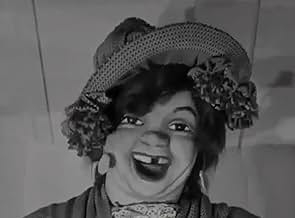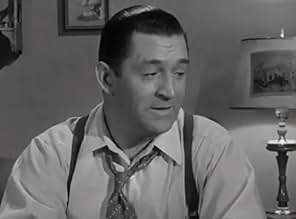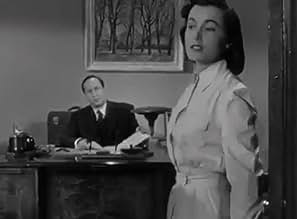IMDb-BEWERTUNG
6,2/10
899
IHRE BEWERTUNG
Füge eine Handlung in deiner Sprache hinzuMany interested parties are after the loot from a factory payroll heist but the mobster who hid it has amnesia after undergoing experimental brain surgery in the prison hospital.Many interested parties are after the loot from a factory payroll heist but the mobster who hid it has amnesia after undergoing experimental brain surgery in the prison hospital.Many interested parties are after the loot from a factory payroll heist but the mobster who hid it has amnesia after undergoing experimental brain surgery in the prison hospital.
Chris Alcaide
- Pursuing Detective
- (Nicht genannt)
Fred Aldrich
- Cop
- (Nicht genannt)
Leonard Bremen
- Guard at Clinic
- (Nicht genannt)
Paul Bryar
- Freddie - Bartender
- (Nicht genannt)
Sayre Dearing
- Patient in Wheelchair at Clinic
- (Nicht genannt)
Frank Fenton
- Detective Driver
- (Nicht genannt)
John Harmon
- Herman
- (Nicht genannt)
Mary Alan Hokanson
- Nurse
- (Nicht genannt)
Shepard Menken
- Interne
- (Nicht genannt)
Howard Negley
- Detective
- (Nicht genannt)
Frank O'Connor
- Gate Guard
- (Nicht genannt)
Empfohlene Bewertungen
Originally made in 3-D, this is another of Columbia's black & white releases of this genre (like Vincent Price in the Mad Magician). 3-D process and numerous subjective camera techniques (like scapels used in operation coming out at the screen, bullets firing at speeding cars, whirling around car rides at an amusement park, etc.)make this interesting viewing and out of the ordinary story about a thug who can't remember anything about his $130,000 heist after brain surgery.
7mk4
Growing up in L.A. always meant a fun trip to Pacific Ocean Park near Venice and riding the "Sea Serpent" roller coaster--and taking a whirl on the "Laff In The Dark" dark ride (while getting creeped-out by the caged "Laffing Sal" in her polka dotted dress who cackled at you from behind bars). "Man In The Dark" takes us back to 1953, and a pre-POP era, when amusement parks were generally seedy and frightening, especially Ocean Park as it was known then (POP came about after Disneyland was built in 1955, and gussied-up by CBS who had purchased it and turned it into a family-oriented theme park-by-the-sea). The "Sea Serpent"--which was "modified for family riding" by CBS in 1957-58 for the new POP, was originally known as the "High Boy"... a John Miller out-and-back masterpiece built circa 1927. This ride was a true thriller...and can be seen to full advantage in this rarely screened noir drama. Laffing Sal was there too, perched above a fun house back then, and she steals the show in many scenes shot to take full advantage of the 3-D process. Since I had experienced both parks back in the '50's through its last season in 1968 before it was torn down, I really wanted to see this movie. I wasn't disappointed. Although not up to the standards of "D.O.A." by a longshot, the movie holds one's interest from the get-go, further capturing the sleeziness old L.A. of the '50's as a place you didn't want to go to if you were trying to stay out of trouble...or if you were on the lam. Edmond O'Brien holds is own, but the other characters do seem a trifle cartoonish to be truly believable. Audrey Totter comes off a little too harsh (even for her) to be considered an attractive prize. The interior shots come off as being filmed a little too flat, but once the film goes on location to the run-down areas around Ocean Park (a real slum at the time), and the park itself, the noir experience kicks-in...Big Time! You can't really call this film a "B-Noir Classic" because its almost impossible to find today...not in the league of "Gun Crazy" (shot at Ocean Park too!) or "D.O.A" or a host of others... but Google it...and you'll find it! Then judge it for yourself.
Edmond O'Brien plays a criminal who is paroled to participate in experimental brain surgery which will remove his criminal impulses as well as his memory. The problem is that his former partners want their shares of $130,000 he stole before he went to jail. (Big Plot problem: Why would O'Brien agree to participate in this experiment if he knew he had a bundle waiting for him? Wouldn't he just do his time?) This B-crime drama, too light in tone to qualify as a Film-noir (check out O'Brien in DOA if you want to see some real Film Noir), with its paper-thin characterizations and dated tough guy dialog, would be easily forgotten if not for its status as the first Big Studio picture released in 3-D. Check it out: It beat "House of Wax" to the screens by one day. I just had the good fortune to see an excellent print of the film today at the Maryland Film Festival. (I should say prints, since it was projected by two cameras simultaneously.) The 3-D experience more than compensated for any deficiencies in the script. (In the film's defense, it does move along quite quickly in its effort to entertain.) I have seen many of the classic 3-D films in their natural format, and I found the 3-D in this film fabulous. Just seeing the black & white Columbia logo itself was worth the price of admission. Oddly, however, the intentional 3-D effects, amusing as they could sometimes be, distracted from the overall 3-D experience. I found myself fascinated simply by the illusion of depth in simple conversational scenes with the occasional object in the foreground. If I were flipping through the channels and watched a bit of this film flat on television, I doubt I would linger very long on it, but the excellent 3-D made it a worthwhile theatrical experience. Check it out if you ever get the chance.
Edmond O'Brien has a severe case of retrograde amnesia, but he didn't contract it in the Pacific. He's a robber who got away with $130,000 in a Christmas Eve heist, was convicted and served his time. But he'll get a second chance if he submits to an operation to excise the criminal portion of his brain. Understandably, he's conflicted, and when they move it up from the scheduled day he balks: `I was born on a Monday. I may as well go on one like dirty laundry.' But the operation proves a stunning success, so delicate that it erases all memories of his past life but leaves him with a perfect command of American slang.
But the placid life he leads at the sanitarium pruning hedges and daubing canvases comes to an abrupt halt when he's kidnaped by his old gang, now led by Ted De Corsia. They want the money, which was never recovered; so does an implacable Javert of an insurance investigator. Even his old girlfriend (Audrey Totter) sees him only as a ticket to the high life, until she falls for the new, improved O'Brien and renounces her grasping ways. (The often ill-used Totter shines here, especially on a martini bender when she asks the bartender, `Oh, Fred, what do you do when you hate yourself?')
Odd clues begin to surface from O'Brien's troubled nightmares, however, leading him and Totter (with the rest of the cast plus the police in pursuit) to claim a parcel left at an amusement park. And this is the big set-piece of the movie, originally released in 3-D. Cars come whooshing around the curves and down the dips of a roller coaster while pitched battles are being fought on the tracks. Watching these 3-D movies now is like drinking soda that's gone flat: All the ingredients are there but the sparkle's gone. But in their endearingly gimmicky way, they evoke their era, as do the flats equipped with party lines and furnished with lampshades bearing reproductions of paintings. Man in the Dark's too short, and needs an extra layer of complexity. But there's still a bit of fizz left in it.
But the placid life he leads at the sanitarium pruning hedges and daubing canvases comes to an abrupt halt when he's kidnaped by his old gang, now led by Ted De Corsia. They want the money, which was never recovered; so does an implacable Javert of an insurance investigator. Even his old girlfriend (Audrey Totter) sees him only as a ticket to the high life, until she falls for the new, improved O'Brien and renounces her grasping ways. (The often ill-used Totter shines here, especially on a martini bender when she asks the bartender, `Oh, Fred, what do you do when you hate yourself?')
Odd clues begin to surface from O'Brien's troubled nightmares, however, leading him and Totter (with the rest of the cast plus the police in pursuit) to claim a parcel left at an amusement park. And this is the big set-piece of the movie, originally released in 3-D. Cars come whooshing around the curves and down the dips of a roller coaster while pitched battles are being fought on the tracks. Watching these 3-D movies now is like drinking soda that's gone flat: All the ingredients are there but the sparkle's gone. But in their endearingly gimmicky way, they evoke their era, as do the flats equipped with party lines and furnished with lampshades bearing reproductions of paintings. Man in the Dark's too short, and needs an extra layer of complexity. But there's still a bit of fizz left in it.
Here's an example of a routine thriller that could have been so much better if the script hadn't been so banal. Unfortunately, nothing really riveting happens until the last twenty minutes when the amnesiac victim enters an amusement park with some startling results.
It's the final chase scene that make the film come to life, but by that time (and even though the running time is brief), many a viewer will be turned off by the pedestrian script and the average performances.
Even old pros like Edmond O'Brien and Audrey Totter look as though they know the script is the problem. Totter, minus her usually scrappy dialog has a colorless role. She plays it straight but makes almost no impression as the woman who wants her boyfriend to amend his old ways after he finds the missing loot that the villains are chasing him for.
It was originally intended to be shown in 3D, and this is obvious from some of the gimmicky B&W photography for the carnival scene. Still, the low-budget aspect of the whole thing is apparent from the start and the final impression is of a quickie B-film unworthy of O'Brien and Totter.
Ted De Corsia has his usual tough guy role as the punk who likes to slam O'Brien around but even he is handicapped by the hackneyed tough guy dialog. Lew Landers directs the story without any distinction until the final scenes at the amusement park.
It's the final chase scene that make the film come to life, but by that time (and even though the running time is brief), many a viewer will be turned off by the pedestrian script and the average performances.
Even old pros like Edmond O'Brien and Audrey Totter look as though they know the script is the problem. Totter, minus her usually scrappy dialog has a colorless role. She plays it straight but makes almost no impression as the woman who wants her boyfriend to amend his old ways after he finds the missing loot that the villains are chasing him for.
It was originally intended to be shown in 3D, and this is obvious from some of the gimmicky B&W photography for the carnival scene. Still, the low-budget aspect of the whole thing is apparent from the start and the final impression is of a quickie B-film unworthy of O'Brien and Totter.
Ted De Corsia has his usual tough guy role as the punk who likes to slam O'Brien around but even he is handicapped by the hackneyed tough guy dialog. Lew Landers directs the story without any distinction until the final scenes at the amusement park.
Wusstest du schon
- WissenswertesThe first 3-D feature ever released by a major American studio. Das Kabinett des Professor Bondi (1953) went into production first, but Columbia rushed "Man in the Dark" - shooting it in a mere 11 days - to get it into theaters just days before "Wax" opened. (Bwana, der Teufel (1952) preceded both of them, but United Artists was not considered a major studio in the early 1950s.)
- PatzerDuring the chase when Steve is abducted, one of the crooks leans out of the car and fires nine shots at the cops from a six-shot revolver.
- Zitate
[first lines]
Cop: You get prettier every day.
Nurse Receptionist: Tell me about the beauty contest you won.
- Alternative VersionenOriginally released in 3D, in prints that were sepia-toned.
- VerbindungenFeatured in TJ and the All Night Theatre: The Man Who Lived Twice (1979)
Top-Auswahl
Melde dich zum Bewerten an und greife auf die Watchlist für personalisierte Empfehlungen zu.
Details
- Laufzeit1 Stunde 10 Minuten
- Seitenverhältnis
- 1.37 : 1
Zu dieser Seite beitragen
Bearbeitung vorschlagen oder fehlenden Inhalt hinzufügen

Oberste Lücke
By what name was Der Mann im Dunkel (1953) officially released in India in English?
Antwort


































